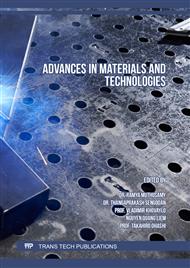[1]
Tennis, P.D.; Leming, M.L.; Akers, D.J. Pervious Concrete Pavements; Portland Cement Association: Skokie, IL, USA, 2004; p.28.
Google Scholar
[2]
Kevern, J.T.; Wang, K.; Schaefer, V.R. Test Methods for Characterizing Air Void Systems in Portland Cement Pervious Concrete. J. ASTM Int. 2009, 6, JAI102451.
DOI: 10.1520/jai102451
Google Scholar
[3]
Huang, B.; Wu, H.; Shu, X.; Burdette, E.G. Laboratory evaluation of permeability and strength of polymer-modified pervious concrete. Constr. Build. Mater. 2010, 24, 818–823. [CrossRef].
DOI: 10.1016/j.conbuildmat.2009.10.025
Google Scholar
[4]
Deo, O.; Neithalath, N. Compressive response of pervious concretes proportioned for desired porosities. Constr. Build. Mater. 2011, 25, 4181–4189. [CrossRef].
DOI: 10.1016/j.conbuildmat.2011.04.055
Google Scholar
[5]
Deo, O.; Neithalath, N. Compressive behavior of pervious concretes and a quantification of the influence of random pore structure features. Mater. Sci. Eng. 2010, 528, 402–412. [CrossRef].
DOI: 10.1016/j.msea.2010.09.024
Google Scholar
[6]
ASTM International. ASTM C1701/C1701M-17a, Standard Test Method for Infiltration Rate of In Place Pervious Concrete; ASTM International: West Conshohocken, PA, USA, (2017).
DOI: 10.1520/stp20120019
Google Scholar
[7]
ASTM International. ASTM C1781/C1781M-18e1, Standard Test Method for Surface Infiltration Rate of Permeable Unit Pavement Systems; ASTM International: West Conshohocken, PA, USA, (2018).
Google Scholar
[8]
International Organization for Standardization. ISO17785-1: 2016: Testing Methods for Pervious Concrete-Part 1: Infiltration Rate; International Organization for Standardization: Geneva, Switzerland, (2016).
Google Scholar
[9]
Schaefer, V.R.; Wang, K.; Suleiman, M.T.; Kevern, J.T. Mix design development for pervious concrete in cold weather climates. In Final Report, National Concrete Pavement Technology Center; Iowa State University: Ames, IA, USA, (2006).
DOI: 10.31274/rtd-20200618-22
Google Scholar
[10]
Ong, S.K.; Wang, K.; Ling, Y.; Shi, G. Pervious Concrete Physical Characteristics and Effectiveness in Stormwater Pollution Reduction. In 2016 Final Report, Institute for Transportation; Iowa State University: Ames, IA, USA, (2006).
Google Scholar
[11]
Yahia, A.; Kabagire, K.D. New approach to proportion pervious concrete. Constr. Build. Mater. 2014, 62, 38–46. [CrossRef].
DOI: 10.1016/j.conbuildmat.2014.03.025
Google Scholar
[12]
Chindaprasirt,P.;Hatanaka,S.;Chareerat,T.;Mishima,N.;Yuasa,Y.Cement paste characteristics and porous concrete properties. Constr. Build. Mater. 2008, 22, 894–901. [CrossRef].
DOI: 10.1016/j.conbuildmat.2006.12.007
Google Scholar
[13]
Cackler, E.T.; Ferragut, T.; Harrington, D.S. Evaluation of U.S. and European Concrete Pavement Noise Reduction Methods; National Concrete Pavement Technology Center, Iowa State University: Ames, IA, USA, 2006; p.96.
Google Scholar
[14]
American Concrete Institute. ACI522.1 - 13Specification for Pervious Concrete Pavement; American Concrete Institute: Farmington Hills, MI, USA, 2013; ISBN 9780870318221.
Google Scholar
[15]
Kishore,R.;Guntakal S.N. Experimental Investigationson Properties of Pervious Concretefor Its Application in Rural Pavements. Int. J. Eng. Res. Technol. 2017, 8, 111–120.
Google Scholar
[16]
Sonebi, M.; Bassuoni, M.; Yahia, A. Pervious Concrete: Mix Design, Properties and Applications. RILEM Tech. Lett. 2016, 1, 109–115. [CrossRef].
DOI: 10.21809/rilemtechlett.2016.24
Google Scholar
[17]
Obla, K.H. Pervious Concrete—An overview. Indian Concr. J. 2010, 84, 9.
Google Scholar
[18]
Endawati, J, Diasti, L., Enung, Characteristics of Pervious Concrete with Environmental Friendly Based Binder, Applied Mechanics and Materials, ISSN: 1662-7482, Vol. 865, pp.263-269, (2017).
DOI: 10.4028/www.scientific.net/amm.865.263
Google Scholar
[19]
Vedat Batu, Aquifer Hydraulics: A Comprehensive Guide to Hydrogeologic Data Analysis, John Wiley & Son, (1998).
Google Scholar
[20]
Soewarno, Hidrologi, Penerbit NOVA, (1995).
Google Scholar



